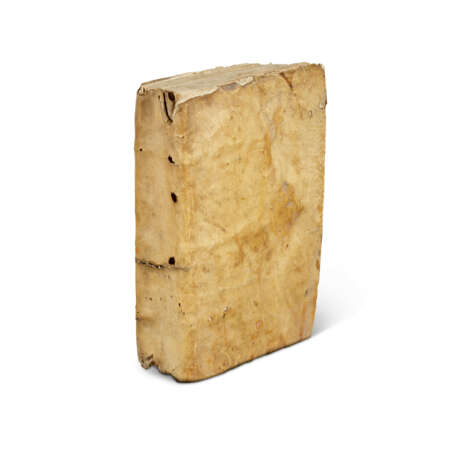AELIUS DONATUS (fl. mid-4th century CE), Johannes SUSENBROT (1464-1543) and two others, anonymous.
13.12.2023 11:00UTC +00:00
Classic
Sold
1512GBP £ 1 512
| Auctioneer | CHRISTIE'S |
|---|---|
| Event location | United Kingdom, London |
| Buyer Premium | see on Website% |
Archive
The auction is completed. No bids can be placed anymore.

ID 1105722
Lot 76 | AELIUS DONATUS (fl. mid-4th century CE), Johannes SUSENBROT (1464-1543) and two others, anonymous.
Estimate value
£ 3 000 – 5 000
A sammelband of three 16th-century printed works relating to the art of letters and rhetoric, and one manuscript containing sermons for the liturgical year.
Sammelband containing two extraordinary rare printed works, one being the first French book to discuss the art of writing letters, and the other being an unrecorded printing of Aelius Donatus’ Ars Minor on Latin grammar. In the 16th century, the art of writing letters was an art in its infancy for the non-professional, and this sammelband brings together three important texts to discuss and introduce the subject, as well as on the related subjects of grammar and rhetoric.
Small octavo (145 x 103mm). Contemporary vellum over old legal manuscript (worn and soiled). Provenance: Claude de Marrignier (16th-century ownership inscription on title) – name of ‘Rossillion’ repeated on endpapers in a 17th-century hand – Thomas Demarrignier (ownership inscription c.1700) – M. Pacthod (presentation inscription on endpaper dated 14 June 1852, to:) – E.F. Starbuck (possibly the French agent for Robert Stephenson & Co., locomotive engineers).
Contents: 1. Le prothocolle des secretaires et aultres gens de´sirans scavoir l' art et maniere de dicter en bon francoys toutes lettres missives et espistres en prose. Paris: Jean Longis for Jean Denis, [c. 1533].
Octavo. Gothic letter. Title in red and black, historiated and criblé initials, large woodcut device of Jean Denis on verso of final leaf (title soiled, B1v adhesion affecting about 7 words, C1 trimmed close to headline just touching a few letters, some very small worming at gutter into one initial and affecting two letters, a couple of tiny insignificant marginal wormtracks to a few leaves, occasional scattered spotting, a few corners dogeared).
The anonymous author specifies the different manners in which to address a correspondent, whether princes, high officials or friends and family. He introduces a broad range of genres for letters and gives specific examples: Lettre escrite au roy en faveur d'un prétendant à l'ordre de chevalerie (letter to the king in favour of an aspirant to the chivalric order), Lettres d'amour (love letters), Lettres domestiques et familières (letters for household- and family-matters), Un bon compagnon de guerre escript à son capitaine (a good wartime comrade writes to his captain) … etc. Particularly interesting in this context is a letter titled Un quidam escrit à un libraire de Paris, notably inquiring about livres proprement et mignonnement reliés. We have only been able to trace one other copy selling at auction, Christie's Important Books and Manuscripts from the Library of Jean Bonna, 16 June 2015, lot 35 (RBH). Alan Montandon, Bibliographie des traictés de savoir-vivre en Europe du Moyen Âge à nos jours, I, p. 31 (for the edition of Oliver Arnoullet, Lyon 1534); USTC no. 45070.
2. Manuscript containing sermons for the year. 29 manuscript leaves, in Latin, collation: 1-28, 313 (of 14, i a cancelled blank), 18 lines written in a 15th-century hand, ruled space: 95 x 67, catchwords survive, penwork initials and flourishes in the margins, the text containing sermons for the liturgical year, beginning with Christmas Day, ‘Parvulus natus est nobis’ and followed by Epiphany, Candlemas, the Annunciation, Easter, etc., and ending with the Feast of Hugh of Lincoln, the final two leaves in a later ?16th-century hand with an extract from the postils of Guillaume de Saint-Amour.
3. AELIUS DONATUS (fl. mid-4th century CE). [Ars] Minor. [No place:] P. G., [no date, but first half of 16th century].
Octavo. 24 ff., collating A-C8. Title page with letterpress ‘Donatus Minor’ set in gothic type above small metal cut clover leaf and woodcut device of a phoenix bearing the name ‘S. Johanes’, within border of 4 woodcuts (title with upper cover torn away with two borders defective, some insignificant worming to gutter, a few leaves dogeared, final leaf stained at fore-edge and slightly chipped).
The Ars Minor of Donatus was a Latin grammar with a very wide circulation in German schools. We have been unable to pinpoint this edition, which seems to be unrecorded in the bibliographies, nor have any copies surfaced at auction (RBH).
4. SUSENBROT, Johannes (1464-1543). Epitome troporum ac schematum et grammaticorum, & rhetorum. Zürich: Ch. Froschauer, [1568].
Octavo. Criblé initials (imperfect, lacking 9 leaves D1, and G2-8, sporadic staining to fore-edges and in gutter). VD 16 S 10289. Frequently published textbook on rhetoric by a schoolmaster who was born in Wangen im Allgau, southern Germany. The work later published in England in 1562, and undoubtedly influenced Shakespeare (see Thomas Whitfield Baldwin, William Shakspere's Small Latine and Lesse Greeke. Urbana, IL: University of Illinois Press, 1944).
| Address of auction |
CHRISTIE'S 8 King Street, St. James's SW1Y 6QT London United Kingdom | ||||
|---|---|---|---|---|---|
| Preview |
| ||||
| Phone | +44 (0)20 7839 9060 | ||||
| Buyer Premium | see on Website | ||||
| Conditions of purchase | Conditions of purchase |





